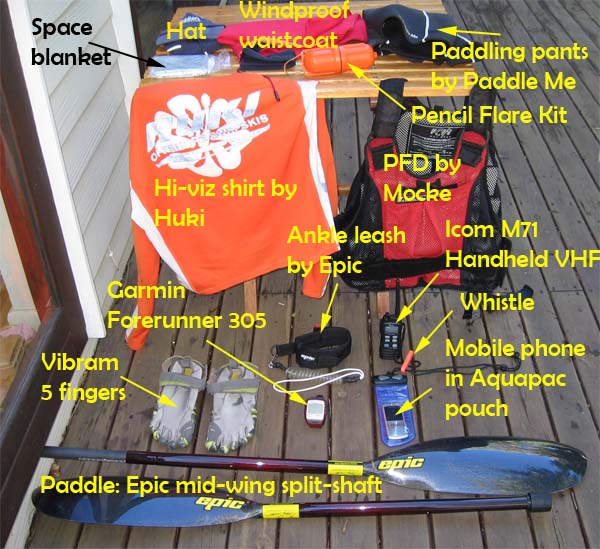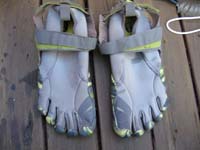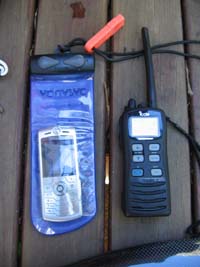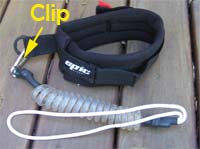Cool Kit - Paddling Gear Inventory
I just reorganized my collection of paddling gear - here's a list of what I use... Some of it's really cool stuff - some of it's just practical. What do you use?

Clothes
Paddle Me paddling shorts: they're cool because they're the only pants I've found that are made without a seam that runs up between the legs - this makes it less likely that they'll chafe my coccyx, a problem that I struggle with (www.paddleme.com).
Huki hi-vis shirt: apart from their being made out of wicking material, I like these shirts because they're made from a high-visibility neon orange - I like being visible out on the water and from experience I know that bright clothing makes it easier for people on other boats to see me. (http://www.huki.com/)

They come in various shapes and sizes - these are the "Flow" style. See http://www.vibramfivefingers.co.za/ for more information.
Hat: My favorite cap was given to me by paddlers.co.za, a shop in Simonstown that specializes in Sea Kayaking. It's cool because it's comfortable. It's also made out of waterproof material so it's warmer than a normal cloth cap - but it also has strips of mesh that allow my head to breath...
Windproof waistcoat: I bought this at Dawid Mocke's shop in Fish Hoek (http://www.thepaddlingcentre.com/). It keeps the wind off my torso and is extremely effective at keeping me warm. I only use it when the conditions are really cold (which for us means about 10-15C!)
Safety Gear
PFD: I use the Mocke PFD - designed by Dawid Mocke. I like it because it's light and comfortable - it doesn't cause you to overheat even in hot weather. It has a big front pocket for all my gadgets and it has a good camelback juice bladder with bite-valve.

The pouch hangs around my neck with the phone tucked away on the inside of my PFD.
Whistle: I keep the whistle on the lanyard of the Aquapac. In tests we showed that the whistle is very effective at attracting attention - but be aware that the sound carries up to ten times further downwind. Our tests were carried out in a 25-30kt wind and although we could hear the whistle only about 50m upwind, the sound carried 400-500m downwind.
Handheld VHF: I use an Icom M71 radio. It's cool because of the features - clever things like dual channel monitoring, etc - but mostly because at 6W transmit power it has more range than most of its competitors.
I keep it tucked away in the front pocket of my PFD.
We tested in exercises with the NSRI and it is the easiest to use, most effective way of talking to your rescuers.
Pencil Flare Kit: Also stored in my front pocket. I've used pencil flares once in anger - when my buddy got into difficulties in Hout Bay a couple of years ago. The flares were called in to the NSRI by numerous onlookers.
We tested them during an exercise with the NSRI and the helicopter crew said that they were very effective. The interesting thing was that although each flare only lasts 5sec or so, the smoke trail remained visible for minutes - and was carried intact downwind.
Space Blanket: (Say what?!) Recommended by the NSRI, we tested a space blanket during our exercise. One of the guys in the water held it out so that it fluttered in the wind. The sun glinted off the slivery material and made it much easier for the helicopter to spot the paddler. It's also useful to wrap around you of course, reducing heat loss and delaying the onset of hypothermia. And it's so small and light that it takes virtually no space in your pocket.

No one piece of safety kit is a "silver bullet" by itself - and clearly what you should take depends on the circumstances. I use almost all of this stuff when I do downwind runs in open water, but it would clearly be overkill for example when doing ins and outs through the surf!
GPS/heart rate monitor: In spite of the fragility of the unit, I still rate the Garmin Forerunner 305 the best combined navigation and training unit on the market. I hate going for a paddle and finding that I've left it behind. I use it as a logging device, a training aid and a navigation tool.
Paddle: Last but not least, I've just started using an Epic mid-wing split shaft paddle (http://www.epickayaks.com/). It's a beautifully made piece of equipment - I really enjoy the lightness of the paddle; and the ability to play with the length and feather angle. Until I started using it, I had a fixed shaft blade, length 2.14m. With the tendency of the top paddlers to use short shafts (for example Herman Chalupsky uses a paddle set to 2.10m), it was great to be able to shorten it and try it out. So far 2.12 seems a very comfortable length and I was complimented on the apparent change in my stroke. Whether or not that has anything to do with the paddle length is up for debate - but something seems to be going better!
(I haven't yet attached my paddle leash to the new paddle; nor have I yet painted the blades neon pink, Greg forgive me! But neon pink blades can be seen kilometers away - literally - and that's a fundamental part of my safety plan.)
Gear up for the conditions
My kit has evolved over the last seven years for paddling in Cape waters. Our water temperature ranges from 8C on the Atlantic side to 20C in False Bay. The air temperature varies from 30C in summer to 10C in winter.
In Hawaii I wore the race "skins" top and felt that it worked well to keep me (relatively) cool. As long as it was wet, I could feel the breeze cooling me down - and it was effective at protecting me from the sun. I'd never use it here in Cape Town of course - except in mid-summer. (And having said that, I still managed to become dehydrated during the course of the race.)
We'd be interested to hear what other people use - both in terms of clothing and safety gear - around the world.

